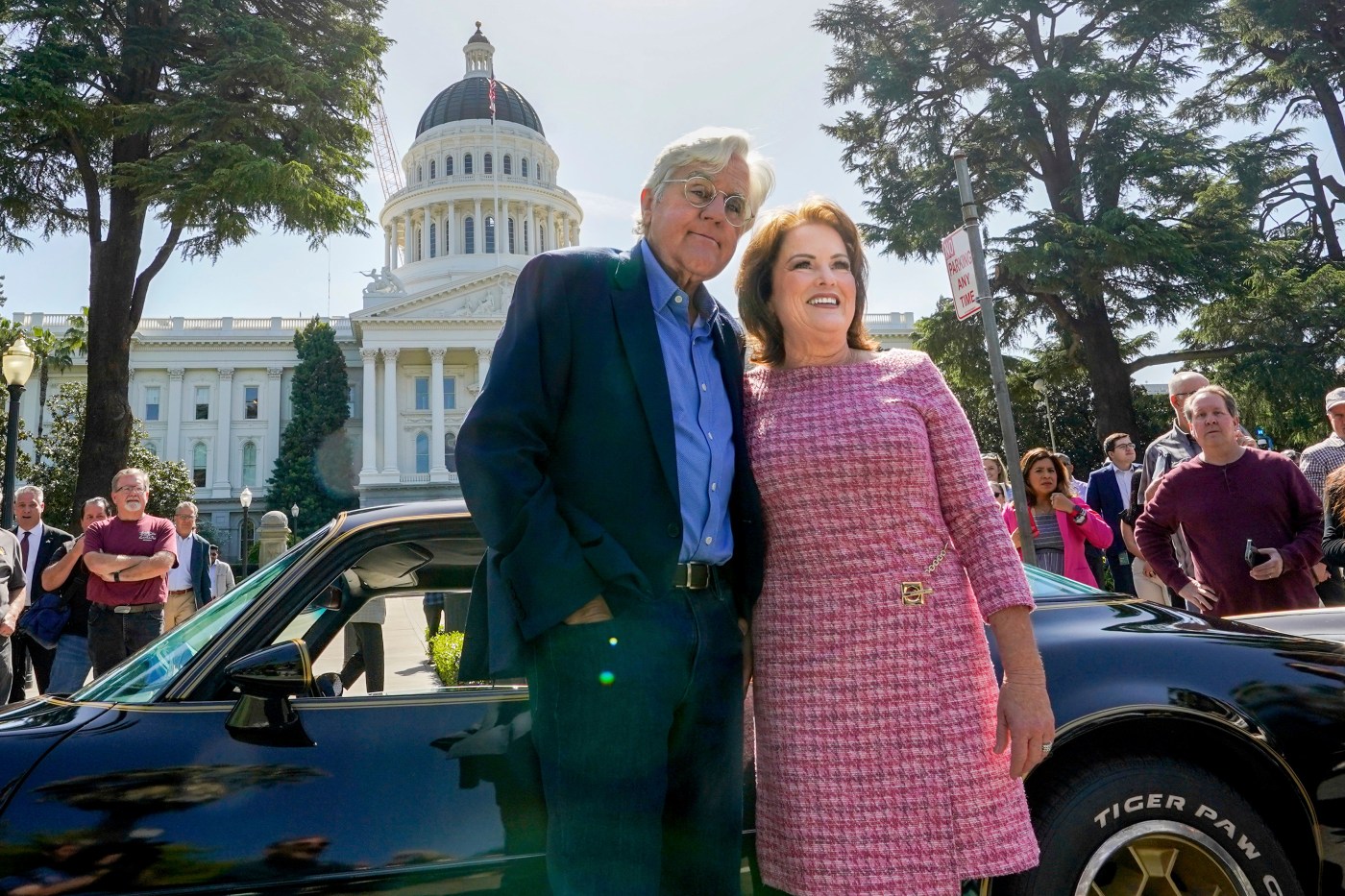
Should old cars get a break from California’s smog check laws?
Former Tonight Show host and avid car collector Jay Leno thinks so. He’s thrown his support behind a bill in the state legislature that would exempt vehicles 35 years or older from the state’s requirement to pass a smog check test that most other California vehicles face every two years.
“I know there’s nothing more annoying than Hollywood people involved in politics,” Leno said at a rally at the state Capitol last month. “But this one’s important to me. I’m an enthusiast.”
Leno, 75, who lives in Burbank, owns an extensive collection of vehicles, including at least 181 cars and 160 motorcycles. There are dozens of rare and exotic vehicles in his collection including a McLaren P1, a Lamborghini Countach, a Ford Model T, a 1928 Bugatti Type 37A, a 1981 DeLorean and a 1909 Baker Electric Car. He writes a regular column about cars for Popular Mechanics and a hosts YouTube series, Jay Leno’s Garage.
Supporters of the bill, dubbed “Leno’s Law,” include classic car owners, hot rodders, and car clubs around the state. They say it is often difficult and expensive for pre-1990 vehicles to pass smog check tests, and there aren’t many of the vehicles left.
“It’s less than 1% of the cars on the road,” said State Sen. Shannon Grove, R-Bakersfield, who is sponsoring the legislation at Leno’s request. “We’re talking about classic car collectors. They cruise around the park. They participate in parades. It’s a very minimal impact. These are car enthusiasts. This gives people an opportunity to restore classic cars they related to in their youth. It’s so few vehicles.”
Waiving smog check rules on a rolling 35-year basis would encourage classic car owners to register their vehicles and keep California — the birthplace of hot rodding and home to many of America’s classic highways — at the forefront of car culture, she and other supporters contend.
But environmental and health groups are lining up against the bill, SB 712. They note that cars from the 1980s and earlier can emit more than 100 times the tailpipe pollution of new vehicles. And allowing them a pass from emissions testing will increase air pollution, asthma, and other public health problems, they say.
“This is one of the most problematic air quality bills of the year,” said Will Barrett, national senior director for clean air advocacy at the American Lung Association. “Older vehicles pollute a lot more than modern vehicles. It’s that much more important to have them in the program to protect against millions of extra miles of smog emissions that would come as a result.”
There have been battles over the issue for years.
California has the most people, the most cars, and the most air pollution of any state, even though air pollution levels have fallen steadily over the past 50 years due to tougher rules on factories, power plants, gasoline and diesel fuel blends, and emissions standards for new cars and trucks.
Under current state law, every vehicle owner must get a smog check every other year unless their vehicle is 8 years old or newer, is an alternative vehicle like an electric car, or is model year 1975 and older.
If a vehicle fails, the owner must repair it and have it tested again until it passes before they can get it registered.
Over the past two years, approximately 342,000 vehicles with a 1976-1990 model year were given smog check tests, according to the state Bureau of Automotive Repair. About 68,000 of those vehicles, or 20% of all vehicles with those model years, failed the smog check
In a letter to legislators last month, the California Air Pollution Control Officers Association said the bill would create “a massive loophole” that would allow all of them starting next year to avoid a smog check, whether or not they are owned by collectors.
“Assuming the 1982 car is driven just 3,000 miles a year, at 123 times the NOx (nitrogen oxides) emissions, it is equivalent to a 2025 passenger car being driven 369,000 miles a year. For daily drivers, the emissions data is even more astonishing,” the letter said. “Using the same emissions numbers as above, a single 1982 car with expected degradation of its pollution control equipment, driven 11,000 miles, is equivalent to 1.353 million miles of NOx emissions from a 2025 car.”
Currently owners of vehicles 35 years and older can receive a less-stringent smog check in California, but only if they show the cars are insured as collector’s vehicles, which often requires proof they are driven a small number of miles a year.
Some owners of old hot rods, low-riders and other vehicles, simply don’t register them.
“You don’t want to make criminals out of people,” Leno said at the rally in April, which included a parade of classic cars. “You have a lot of people, they drive an older car. They have had it a long time. They maintain it. They say I can’t get it smogged, so now they’ve got to sneak around, or get a guy to give them a phony piece of paper.”
The bill cleared an early vote by a 12-2 bipartisan majority at the Senate Transportation Committee last month. But after the DMV and other agencies said it would cost hundreds of thousands of dollars a year in lost fees and expenses to change state computer systems, Democrats on the Senate Appropriations Committee put it in the “suspense file,” a place where some bills are killed quietly, but where some are released for a vote on the full Senate floor. The final decision on that is expected in the next two weeks.
“These cars are exciting,” said Hal Schuette, a San Carlos collector who drove his 1964 Cadillac convertible in the Giants and Warriors championship parades. “People love them. Sooner or later they’ll go away. We should get a break.”